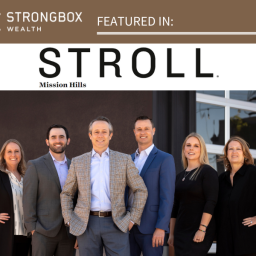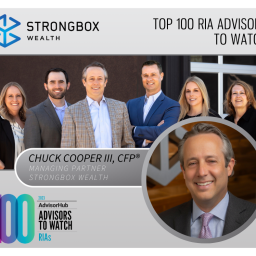
By Diana Britton
January 25, 2024
Chuck Cooper III, advisor and managing partner at Lee’s Summit, Mo.-based StrongBox Wealth, provides a peek inside the $400 million RIA’s stock picking strategy within its high conviction, conservative growth model portfolio.
Financial advisor Chuck Cooper III and his team broke away from Wells Fargo Advisors in 2019 to form a new registered investment advisor, StrongBox Wealth, joining Dynasty Financial Partners’ network.
Today, the Lee’s Summit, Mo.-based RIA manages about $400 million for primarily high-net-worth clients, said Cooper, managing partner of StrongBox. For some of the firm’s smaller satellite accounts, it uses an active/passive approach with a blend of ETFs and funds. But for those in the larger qualified accounts, which often typify the RIA’s relationships, it uses a conservative growth model, which invests in individual stocks.
In our latest What’s in My Model Portfolio? interview, Cooper provides a look inside the RIA’s conservative growth model.
The following has been edited for length and clarity.
WealthManagement.com: What’s in your model portfolio?
Chuck Cooper III: One high conviction model that we like just given where the markets are right now is this conservative growth model, and it’s comprised of 72% equity, 22% fixed income, 3% alternatives and 3% in cash. So, some would frame that as 75/25, but we break it down a little bit further with the 3% in alts, which is really just publicly-traded REITs. And then cash base component, which is a purchase money fund, a government securities 5% rate.
WM: How do you break down the equity allocation?
CC: Of the equity component, the 72%, half of that is in large-cap domestic. About 8% in mid-caps, 4% in small-caps, about 15% and change in international, and about 4% in emerging markets. On the style front, it’s about an even weight. Of the domestic large-cap allocation, it’s about 12% core, about 12% value, and about 14% growth.
WM: What does the fixed income portfolio look like?
CC: The allocation is comprised of some actively managed mutual funds in the multi-sector and intermediate core space along with some exposure to the JPMorgan Ultra-Short Income ETF (JPST), which of course was a rather substantial position for a lot of RIAs.
But nonetheless, we also have the exposure in passive bond ETFs, such as the VGIT with the 6% position. We also have some BlackRock strategic income exposure, which we kept through the tightening cycle because they have some duration hedge that they use. We also have a PIMCO income fund.
WM: Have you made any big investment allocation changes in the last six months to a year? If so, what changes?
CC: We have a growth overweight by a few percentage points, but we had taken off a greater overweight here recently.
On the equity front, for example, in the second quarter of last year, we introduced Broadcom, Linde in third quarter, and Medtronic in fourth quarter. And we made room for those positions by eliminating a couple deep value, cyclical names in second and third quarter. And then while also trimming our energy overweight to an underweight in fourth quarter.
So some of it was from a style standpoint, some of it was from a sector standpoint, but that’s what really drove it back to a little bit more of a growth tilt in particular, with eliminating some of the deep value cyclical names in the second and third quarter of last year.
But I wouldn’t say those were big asset allocation changes. Our major asset allocation changes were in the years prior.
For example, we were real heavy on the value side, on the energy side and even in financials, healthcare and industrials in 2022. And then at the beginning of 2023, we went back to growth on stylistically. And as you would expect, we have a lot of the usual suspects, and we allowed those to run. We didn’t rebalance those down because clearly growth was way in favor.
We had remarkably short duration within fixed income during most of the fed’s tightening cycle. However, in the second quarter of last year, we started extending duration by adding a 3% VGIT position, which is a plain vanilla Vanguard intermediate-term U.S. government securities ETF. And that was at the expense of a one to three year duration ETF. And that was simply done given the natural expectation for intermediate bonds to perform well when rates stabilized and pivot lower.
So while the Fed tightening played out as everyone anticipated, we then doubled our positioning in intermediate government exposure to 6% in the third quarter rebalance. And we’re comfortable with the exposure at those current levels, given the run-up in bond prices over the last few months.
At the same time in the third quarter, we also jettisoned an intermediate TIP mutual fund, given the nominal rates moved ahead of the CPI rate. We felt that the merit of the inflation component to the TIP position had faded and preferred to collect the higher gross income while still benefiting from the intermediate duration tailwind.
Financial advisor Chuck Cooper III and his team broke away from Wells Fargo Advisors in 2019 to form a new registered investment advisor, StrongBox Wealth, joining Dynasty Financial Partners’ network.
Today, the Lee’s Summit, Mo.-based RIA manages about $400 million for primarily high-net-worth clients, said Cooper, managing partner of StrongBox. For some of the firm’s smaller satellite accounts, it uses an active/passive approach with a blend of ETFs and funds. But for those in the larger qualified accounts, which often typify the RIA’s relationships, it uses a conservative growth model, which invests in individual stocks.
In our latest What’s in My Model Portfolio? interview, Cooper provides a look inside the RIA’s conservative growth model.
The following has been edited for length and clarity.
WealthManagement.com: What’s in your model portfolio?
Chuck Cooper III: One high conviction model that we like just given where the markets are right now is this conservative growth model, and it’s comprised of 72% equity, 22% fixed income, 3% alternatives and 3% in cash. So, some would frame that as 75/25, but we break it down a little bit further with the 3% in alts, which is really just publicly-traded REITs. And then cash base component, which is a purchase money fund, a government securities 5% rate.
WM: How do you break down the equity allocation?
CC: Of the equity component, the 72%, half of that is in large-cap domestic. About 8% in mid-caps, 4% in small-caps, about 15% and change in international, and about 4% in emerging markets. On the style front, it’s about an even weight. Of the domestic large-cap allocation, it’s about 12% core, about 12% value, and about 14% growth.
WM: What does the fixed income portfolio look like?
CC: The allocation is comprised of some actively managed mutual funds in the multi-sector and intermediate core space along with some exposure to the JPMorgan Ultra-Short Income ETF (JPST), which of course was a rather substantial position for a lot of RIAs.
But nonetheless, we also have the exposure in passive bond ETFs, such as the VGIT with the 6% position. We also have some BlackRock strategic income exposure, which we kept through the tightening cycle because they have some duration hedge that they use. We also have a PIMCO income fund.
WM: Have you made any big investment allocation changes in the last six months to a year? If so, what changes?
CC: We have a growth overweight by a few percentage points, but we had taken off a greater overweight here recently.
On the equity front, for example, in the second quarter of last year, we introduced Broadcom, Linde in third quarter, and Medtronic in fourth quarter. And we made room for those positions by eliminating a couple deep value, cyclical names in second and third quarter. And then while also trimming our energy overweight to an underweight in fourth quarter.
So some of it was from a style standpoint, some of it was from a sector standpoint, but that’s what really drove it back to a little bit more of a growth tilt in particular, with eliminating some of the deep value cyclical names in the second and third quarter of last year.
But I wouldn’t say those were big asset allocation changes. Our major asset allocation changes were in the years prior.
For example, we were real heavy on the value side, on the energy side and even in financials, healthcare and industrials in 2022. And then at the beginning of 2023, we went back to growth on stylistically. And as you would expect, we have a lot of the usual suspects, and we allowed those to run. We didn’t rebalance those down because clearly growth was way in favor.
We had remarkably short duration within fixed income during most of the fed’s tightening cycle. However, in the second quarter of last year, we started extending duration by adding a 3% VGIT position, which is a plain vanilla Vanguard intermediate-term U.S. government securities ETF. And that was at the expense of a one to three year duration ETF. And that was simply done given the natural expectation for intermediate bonds to perform well when rates stabilized and pivot lower.
So while the Fed tightening played out as everyone anticipated, we then doubled our positioning in intermediate government exposure to 6% in the third quarter rebalance. And we’re comfortable with the exposure at those current levels, given the run-up in bond prices over the last few months.
At the same time in the third quarter, we also jettisoned an intermediate TIP mutual fund, given the nominal rates moved ahead of the CPI rate. We felt that the merit of the inflation component to the TIP position had faded and preferred to collect the higher gross income while still benefiting from the intermediate duration tailwind.
WM: What differentiates your portfolio?
CC: What primarily differentiates the portfolio is individual stock positioning and the sector exposure within the model’s domestic large cap allocation. My fundamental belief is that it is as important what you own as what you do not own.
And historically, generating alpha in the U.S. domestic large-cap space within passive or active vehicles—we have not given that favor as our preference. Within our mid-cap, small cap international and emerging manager exposure, we actively seek out passive ETFs and active mutual funds and even active ETFs for that matter because we do not own individual stocks in those asset classes.
So we believe to warrant model inclusion, a company must first possess quality fundamentals as those have consistently shown to whatever time. And price momentum alone cannot factor in as a justification to own a company because, simply put, multiple expansion and positive sentiment have historically shown to be fleeting reasons to own. Take the Magnificent 7, for example, as their collective performance trounced the S&P index last year. And still as of 2023 year-end, the top 10 market cap stocks in the S&P, which the Magnificent 7 are all within, had a forward price-to-earnings ratio of 27, while the rest of the S&P had a forward multiple of around 17.
We believe a stock should be owned at a reasonable and relative underlying value. And if underlying earnings growth supports the PE, then by all means we will consider it for inclusion. But it’s our duty to own reasonably-priced stocks in client portfolios. And we just feel that in the conservative growth portfolio, it should be represented by market leaders with deep moats, solid earnings growth trajectory possessing very high quality fundamentals led by excellent management teams while the stock itself being priced at a reasonable level.
And then as important, most of the model stocks have a proven history of rising dividends and ample profits to provide additional investment income growth. We believe that returning capital to shareholders through a stream of regularly increasing dividends has shown to be a distinct mark of a consistently solid stock to own. It’s not lost on StrongBox Wealth that the dividend component to the total return of the S&P 500 has been 33%, near one third over the last near 100 years. So in an era of renewed inflation, we recognize that pay raises from dividends have historically provided an income escalator and therefore should occupy a significant portion of the domestic large cap exposure in individual names.
But equally, there’s a whole part of the domestic large cap space that we don’t want to have any part of. Companies with thin margins, with high debt levels, with low earnings growth that do not own their space, meaning they’re not category killers within their space.
WM: What are some of your top stock picks? What factors go into your equity selection?
CC: Our top long-term stock picks, meaning these have occupied space within the model for many years, are some of the usual suspects in technology like Apple, Microsoft and Visa. But in other sectors we have long owned companies like Eaton—they’re in industrials, Costco, Danaher and Alphabet. I still think of that as a tech company, but of course it’s a communications company. In the past year, we’ve added Blackstone, which has really been a very strong performer because other than JPMorgan, it’s the only other financial stock we have.
We also added Broadcom, and obviously it did extraordinarily well with the whole AI and chip phenomenon. And then we added Linde; it’s a British company in industrial gasses, which has done extraordinarily well.
WM: What’s your due diligence process for choosing asset managers or funds?
CC: It’s largely a quantitative process. We leverage the gold standard of research in Morningstar. We screen for four or five stars. We screen for gold, silver, bronze. We select the lowest cost share class offered, all institutional. We generally custody at Schwab, so whatever that may be, whether it’s an NTF fund or not, we’re screening for the lowest cost share class offered.
So for example, with American Funds, we’re using F-3 shares. We remove funds with average expenses and volatility, and again, that’s using Morningstar’s data. We screen for style box or benchmark consistency so as to remove drift, and we typically will utilize Riskalyze along those lines. We rank and score five and three year rolling performance.
And then we rank and score fund risk stats, like beta, alpha. We risk and score risk adjusted returns, like Sharpe ratio, we rank and score fund expense ratios. And then we aggregate them and use it basically as a tool for fund inclusion or not. So in effect, we create the screen, our due diligence process to say, “Here’s our bench of players. Do we want them on the field? Do we want them deployed in the model?” And if so, then they’re pulled off the bench, and they’re in the model.
If for whatever reason, through our judgment on the mid-range views on the economy and/or markets, we feel that that player should go back to the bench or be utilized in a different way, then we’ll make the adjustments.
We’ve already gone through that due diligence process. In other words, we are not all of a sudden looking for an option and then having to go vet something. We feel like we have a full suite of inventory options to deploy, and it’s just a matter of which ones we want and in what amount at any given time.
Sometimes altogether there are different funds or ETFs that might be in a more aggressive growth model versus not at all in a conservative growth and income model. So we don’t look at it in the sense of just due diligence for the one model. We look at it holistically as to what is the stable of investment products that we will deploy throughout the spectrum of risk-based models that we manage.
WM: How are you addressing the inflationary environment within the portfolio? How are you addressing “higher for longer” interest rates?
CC: We’re addressing higher inflationary environment by owning companies that have shown, again, that consistent ability to increase dividends and return of capital for shareholders. And to us that is a primary determinant in model inclusion. And for the most part, these individual companies have increased dividends at multiples of the CPI rate, let alone match it.
On the higher for longer narrative, as with most people who have been in the business a good long while, I learned not to fight the feds, but still they need to reinforce their narrative until data shows otherwise to warrant a pivot. So accordingly, we’ve extended the duration on that fixed income portion, but have not gotten too excited about foregoing any short-term positioning. So a year ago the model was positioned about two to one, short to intermediate, again with intermediate duration exposure, partially hedged even.
Model exposure now has been sequentially rebalanced to be even at one-to-one as we’ve become more comfortable in extending duration over the last few quarters.








